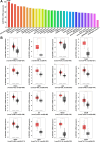Targeting the glutamine-arginine-proline metabolism axis in cancer
- PMID: 39051546
- PMCID: PMC11275534
- DOI: 10.1080/14756366.2024.2367129
Targeting the glutamine-arginine-proline metabolism axis in cancer
Abstract
Metabolic abnormalities are an important feature of tumours. The glutamine-arginine-proline axis is an important node of cancer metabolism and plays a major role in amino acid metabolism. This axis also acts as a scaffold for the synthesis of other nonessential amino acids and essential metabolites. In this paper, we briefly review (1) the glutamine addiction exhibited by tumour cells with accelerated glutamine transport and metabolism; (2) the methods regulating extracellular glutamine entry, intracellular glutamine synthesis and the fate of intracellular glutamine; (3) the glutamine, proline and arginine metabolic pathways and their interaction; and (4) the research progress in tumour therapy targeting the glutamine-arginine-proline metabolic system, with a focus on summarising the therapeutic research progress of strategies targeting of one of the key enzymes of this metabolic system, P5CS (ALDH18A1). This review provides a new basis for treatments targeting the metabolic characteristics of tumours.
Keywords: ALDH18A1; Glutamine; cancer; metabolism; proline.
Conflict of interest statement
The authors report no conflicts of interest.
Figures





References
Publication types
MeSH terms
Substances
LinkOut - more resources
Full Text Sources
Medical
Miscellaneous
